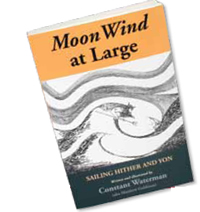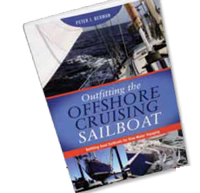
The summer reading season is upon us, and the editors at Practical Sailor have selected 10 titles worth reading during the lazy days and easy nights ahead.
Walter R. Borneman’s “The Admirals: Nimitz, Halsey, Leahy and King – The Five-Star Admirals Who Won the War at Sea,” (Little, Brown and Company, 2012, $18, Kindle $15, audio $22) is a great pick for marine history buffs. It is a large and powerful narrative of the only five-star fleet admirals in U.S. history. These four United States Naval Academy graduates led the U.S. to victory in World War II, and turned the Navy into a global force. The story is told through the relationships between the men, their egos and arguments, their camaraderie, and their counsel, patience and war time tactics. Author Borneman has written seven other nonfiction books and holds a master’s degree in history and law.
“Beyond the Blue Horizon: How the Earliest Mariners Unlocked the Secrets of the Ocean” (Bloomsbury Press, 2012, $19, Kindle $15, not available in audio), written by Brian Fagan, is another compelling book of maritime history. “Beyond the Blue Horizon” looks at how early mariners’ mastery of the ocean changed the course of human history. Why did these sailors take off for unexplored waters? What compelled them to search for new lands? Was it hunger, trade, curiosity? Fagan mixes anecdotes, archeology, and imaginative fiction in this salty historical work. From the first chapter to the last page, the reader is carried along with the trade winds, side-by-side with Micronesian, Polynesian, Egyptian, Greek, and Norse sailors. Born in England, Fagan has decades of sea experience and has authored several best-selling non-fiction titles as well as the “Cruising Guide to Central and Southern California.”
Another sailor-turned-writer, Nathaniel Philbrick combines his love of sailing, history, and literature in his impassioned and enthusiastic book: “Why Read Moby Dick?” (Viking, 2011, $16, Kindle $12, audio CD $16, audio download $12). With unabashed excitement, minute detail, philosophical query, and humor, Philbrick breaks down Herman Melville’s “Moby-Dick,” convincing the reader to dive into this daunting American classic without looking back. The best-seller author argues that 161-year-old “Moby-Dick” is relevant now more than ever before. He also authored “In the Heart of the Sea,” the epic story of the whaling ship Essex and the real-life events that inspired Melville’s classic.
“The Sea is My Brother” (Da Capo Press, 2012, $16, Kindle $11, audio CD $23, audio download $10) is the recently published “lost novel” by Jack Kerouac, who often is called the father of the Beat Generation. In the spring of 1943, while working as a merchant seaman, 21-year-old Kerouac set out to write his first novel. Written entirely by hand, “The Sea is My Brother,” went unpublished in North America until now, 70 years after its completion. A clear precursor to Kerouac’s 1957 classic, “On the Road,” the book details his adventures as a young seaman, offering a glimpse of a young man whose youthful idealism is at odds with the harsh realities of a nation at war.

As intriguing and addictive as sailors’ search for mermaids, “Moon Wind at Large, Sailing Hither and Yon” (Breakaway Books 2011, $11.66, Kindle $7.99, not available in audio format), written by Constant Waterman (aka Matthew Goldman), is a collection of meandering and compelling tales of life messing about in boats. His lyrical storytelling and beautiful prose—along with his entertaining bend and quirky drawings—make this swirl of stories of a life well wasted near his home waters in New England a fulfilling and thought-provoking read.

After years of preparation and research, 25-year-old James Baldwin left South Florida with the intent to sail around the world alone. “Across Islands and Oceans” (Atom Voyages, 2012, $10, not available in electronic or audio format), is the story of Baldwin’s two-year circumnavigation. Baldwin’s crisp, clear writing carries the reader forward, like the trades that pull his trusty 28-foot Pearson Triton across the Caribbean, toward the Pacific and Indian oceans, returning through the Atlantic to the coast where he started. Baldwin’s commitment to hike across every island he visits adds to his adventure. Written 25 years after he completed his voyage—with the help of photo albums and journals—the book has a reflective tone as Baldwin examines his own growth during the journey and the many lessons he learned that only the sea can teach.
Renee D. Petrillo’s “A Sail of Two Idiots” (International Marine, 2012, $13, Kindle $12) is an entertaining and easy-to-read book about “100+ lessons and laughs from a non-sailor who quit the rat race, took the helm, and sailed to a new life in the Caribbean.” Petrillo’s story began with her and her husband’s dream to sell everything, buy a boat, and sail off into the sunset, and like many similar cruiser stories, she found that living the dream could be hard work. Determined to save future dream-seeking sailors from the same hurdles she faced, Petrillo passes along her stories and wisdom in “A Sail of Two Idiots.”
When the fierce winds off the coast of Nova Scotia force a small boat into port, the boat’s pilot, eccentric Capt. Charles Johnson, takes up residence at the small inn run by young Jim and his mother. With each day, the captain’s presence becomes increasingly valuable to the family as they struggle to keep the inn open for business—and his past becomes evermore mysterious as Jim discovers how much the captain knows about the lives and battles of the old-time pirates. “Pirate’s Passage” (Trumpeter/Shambhala Publications, 2006, $12, not available in electronic or audio format), written by William Gilkerson, is an award-winning young adult’s novel, with enough excitement and adventure for pirates of any age. Gilkerson is a sailor, painter, journalist, historian, and adventurer. He has written 10 nautical nonfiction books and lives with his family on the shores of Mahone Bay, Nova Scotia, where he sails his ancient cutter, Elly.
Sprague Theobald, an award-winning documentary filmmaker with over 40,000 offshore miles under his belt, always considered the Northwest Passage—the sea route connecting the Atlantic to the Pacific—the ultimate uncharted territory. Since Roald Amundsen completed the first successful crossing of the fabled Northwest Passage in 1906, fewer than 30 pleasure craft have followed in his wake. What Theobald couldn’t have known was just how life-changing his journey through the Passage would be. Reunited with his children and stepchildren after a bad divorce more than 15 years before, he and the other family members embark with unanswered questions, untold hurts, and unspoken mistrusts hanging over their heads. “The Other Side of the Ice” (Skyhorse Publishing, 2012, $17, not available in electronic or audio format) is the story of the family’s adventure. Unrelenting cold, hungry polar bears, a haunting landscape, and crew clashes make “The Other Side of the Ice” a harrowing story of survival, adventure, and, ultimately, redemption.

In Peter I. Berman’s “Outfitting the Offshore Cruising Sailboat” (Paradise Publications, 2011, $20, not available in electronic or audio format), Berman details how to buy a used fiberglass sailboat and refurbish it for offshore cruising. Sharing his 40-plus years of experience in overhauling and refitting a myriad of different sailboats for offshore cruising, Berman offers straight-forward advice on rigging selection, engines, ground tackle, safety gear, electronics installations, and the hull.





































